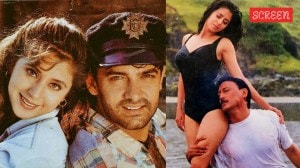Can you have abs like Shah Rukh Khan, 57, in Pathaan? How to focus on being fit over fab if you are 50?
‘They say if you start in your 20s, you reap benefits of the chiselled look in your 50s. But fitness is more than just about showing abs. It is about having the five mantras of functionality and the organs running in top gear,’ says functional medicine expert and celebrity health coach Vijay Thakkar
 He has been body-training for 24 years to be career-ready all the time. (Photo: Shah Rukh Khan/Instagram)
He has been body-training for 24 years to be career-ready all the time. (Photo: Shah Rukh Khan/Instagram) If you are wondering how Shah Rukh Khan got his toned abs at 57, then know that he has been body-training for 24 years to be career-ready all the time. As for his lean mean look in Pathaan, his trainers have already said that’s the result of four years of consistent effort, a sustained exercise routine geared towards an intended goal, diet and wellness, without defaulting through the lockdown. Thanks to the success of the film, many 50-year-olds and above have been encouraged to take that step towards fitness. Many with a middling age profile are already signing up with functional trainer and celebrity health coach Vijay Thakkar. And the big question that some of them are asking is if they can develop abs too.
“Of course, with professional actors, the goal-orientation is linked to the project, whereby there is a battery of physicians, trainers, physiotherapists and chefs. The outlook is also look-oriented but I would say the goal for regular people should not be periodical but long-term and most importantly, should be fitness-oriented. Yes, you may develop abs if you have been relatively fit for about two decades at least. Remember muscles have memory and can prime themselves to future stress. They say if you start in your 20s, you reap benefits in your 50s. Fitness is more than just showing abs, you have to have a good structure. But even if you do not and are starting out on your fitness journey post 50s (and I have many heart patients too coming for cardio-rehabilitation), you must take it slow and easy, build up a rhythm with small efforts like walking and stretching, sync yourself with your body threshold and, let me emphasise, do your medical evaluation and stress tests with your doctor. Then we can customise a routine for you,” says Thakkar.
He has enough 50-year-olds who had enrolled with him from the time they were 42. “Today they are better than 35-year- old in terms of body functionality and fitness,” he says.
WHAT ARE THE FIVE MANTRAS TO FOCUS ON FOR ANYBODY AFTER 50 SEEKING A FIT BODY?
The first, according to Thakkar, is basic functional strength. “This means you need to build up enough strength so that when you squat or fall down, you can get up and gather yourself without injuring your shoulder and head. Remember as you age and your muscles degenerate, you are subjected to gravity more. That’s why you tend to have more falls and need to build your muscular strength,” says he.
The next is muscular endurance. “While the heart and lungs pump oxygenated blood, that’s half the job. How your muscles use the oxygen is the other half. The source of energy that is used to power the movement of contraction in working muscles is adenosine triphosphate (ATP) – the body’s mechanism for storing and transporting energy. But since ATP cannot be stored, the body must start making it quickly. Without ATP, your energy currency, you cannot detoxify your body,” adds Thakkar.
The third most important factor is cardio-vascular endurance. “Often you may feel a burn in your legs while exercising. This means that there has been a build-up of lactic acid in your muscles during intense exercise. This means the muscle lacks oxygen. Lactic acid is a byproduct of anaerobic metabolism, in which the body produces energy without using oxygen. So that burn must go to begin with,” says Thakkar.
The fourth factor is flexibility, where joints become restrictive and the spine, shoulder and neck become less mobile. “You can get injured very easily, so oiling the joints with targetted exercise and movements becomes important,” he adds.
The fifth factor has to do with your body composition, the fat and non-fat weight. You need both subcutaneous and some form of fat around the organs to protect them from extremities of temperature and external weather. “About 15 per cent of a man’s body weight should be fat. For women, the limit should be 20 per cent. This is when, along with the four mantras listed above, your body is ready for abs. Then there is the connective tissue around muscles called fascia, which stiffens up and forms cellulite. The moment the fat in your body goes lower than these upper limits, even by a small percentage, your abdominal fat begins to show,” says Thakkar.
DO NOT KEEP HIGH EXPECTATIONS: HOW TO EXERCISE
Do not do anything which pushes up your cardio-metabolic risk but keep everything within limit and ensure that organs function normally. “Be consistent with your exercise. Begin with 10,000 steps daily, taking time out every half hour for five minutes of walking. Then you should reserve two to three days a week, in an alternative format, for resistance and strength training, which involve squats, lunges, push-ups, crunches from the floor and pull-ups. You must weave in yoga as it stretches your body and is a good component of your flexibility regime,” he adds. “Do not chase unrealistic goals of working out for three hours when you know you cannot maintain it. Go for one hour but do it consistently. Otherwise, you will burn out and the output will never match your expectation,” he warns.
WHAT TO EAT?
Thakkar now suggests that millets be a huge part of our diet, and that we mix wholegrains, vegetables, fruits, soups, nuts, seeds, poultry, seafood and meat. “It should be a good mix of proteins with wholegrains, healthy fats and good quality, slow digesting carbs. And eating out should be calculated and planned in advance, so that you know how to balance the impact with your regime,” advises Thakkar. Also, he recommends drinking three litres of water as it helps in healing, recovery, cleansing and transport of nutrients.
A REALISTIC REGIME
The body has to be allowed time to recover and the mind must back that up by being calm and in a meditative state. Thakkar shares his own routine with us. “After seven to eight hours of sleep, I do 45 minutes of cardio (be it a jog, walk and run), then I meditate for five to eight minutes. Don’t meditate and exercise, because then the parasympathetic nervous system (rest and digestion) gets activated first. Then with a jerk, the sympathetic nervous system (the fight or flight mode with dopamine) gets worked up. Instead, work your body, then relax and let the enteric nervous system (gut and motor functions) take over with breakfast. Older people will take a bit longer because they also go through hormonal changes. Nudging your body shouldn’t be about shoving. You must give stimulus to your body to improve and adapt itself. There are no bad workouts but workouts not done the right way,” shares Thakkar.
Photos
- 01
- 02
- 03
- 04
- 05






























